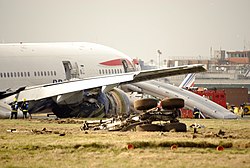US, UK investigators seek 777 engine redesign to stop repeat of London jet crash
Saturday, March 14, 2009

Investigators with the National Transportation Safety Board in the United States have issued an 'urgent safety recommendation' in connection to their role alongside the United Kingdom's Air Accidents Investigation Branch in investigating loss of power in Rolls-Royce engines on Boeing 777s, with the AAIB following suit. One of them resulted in British Airways Flight 38 crashing short of the runway at London's Heathrow Airport last year. The NTSB and the AAIB want Rolls-Royce to redesign the engines.
Both events occurred on Boeing 777-200ER airplanes powered by Rolls-Royce RB211 Trent 800 Series engines. On January 17, 2008 British Airways Flight 38 experienced a dual engine rollback (reduction of engine power) on final approach to Heathrow and crashed, leaving one passenger seriously injured, eight passengers and four of the flight crew with minor injuries and the airplane written off.
The second event occurred on November 26, 2008, when a Delta Air Lines Boeing 777 experienced a single engine rollback during cruise flight over Montana, United States while en route from Shanghai to Atlanta. Normal operations resumed after the flight crew followed Boeing's published procedure to recover engine performance and the airplane landed safely in Atlanta.
Boeing has already developed new procedures after the crash to prevent ice from building up within their 777 fuel systems after it became apparent that icing may have been a factor, and it was some of these that the Delta flight crew had followed. Boeing modified these further after the Delta incident. As part of the recent releases by the NTSB and AAIB it has become apparent that investigators from both bodies, which are collaborating, have found ice buildup in the fuel system caused both rollbacks.
In both cases a build-up of ice (from water normally present in all jet fuel) developed on a component called the fuel/oil heat exchanger. This restricted the flow of fuel to the engine, resulting in the uncommanded engine rollback. Investigators initially struggled to produce enough ice under test conditions but have now found that at high concentration, fuel can form ice at very low temperatures in enough quantity to seriously restrict fuel flow, according to a new interim report by the AAIB. This does not occur when fuel demand is lower, as the hot oil then becomes sufficient to entirely melt the ice. The British jet experienced very low temperatures over Siberia.

The vigorous tests are thought to be the first of their kind. They have also confirmed that while ice may have formed elsewhere in the airliner's fuel system fuel was probably not restricted at any other location. Instead, it is thought 'soft' ice formed in the pipes and then broke off, travelling to the fuel/oil heat exchanger and restricting it.
The NTSB has now revealed that they have advised Rolls-Royce to redesign the fuel/oil heat exchanger, and Rolls-Royce have stated that they are indeed working on a replacement part that will be available within twelve months. The AAIB advised Boeing and Rolls-Royce to jointly review the problem across the fuel system, and both companies responded that they 'accepted' this recommendation and repeated that a replacement part was being developed.
Both the NTSB and the AAIB also sent letters to the US Federal Aviation Administration and the European Aviation Safety Agency requesting the installment of the modified component be mandatory. The NTSB suggested this should be either the next maintenance check or within six months. There are 220 Boeing 777-200s - the only type using the affected engine - with Trent 800 series engines.
The fuel/oil heat exchanger is a dual purpose part designed to simultaneously melt fuel ice and cool down engine oil.
The AAIB further noted that it is unclear weather other aircraft designs are at risk, and advised the FAA and EASA to look into increased use of de-icing additives and investigate both the accumulation and sudden movement of ice in aircraft fuel systems and the actual formation of ice in the fuel itself.
Related news
- "Interim report blames ice for British Airways 777 crash in London" — Wikinews, September 6, 2008
- "US, UK investigators collaborating after US 777 incident similar to London crash" — Wikinews, December 18, 2008
Sources
- "'High risk' of plane fault repeat" — BBC online, March 13, 2009
- "NTSB Issues Urgent Safety Recommendation To Address Engine Thrust Rollback Events On B-777 Aircraft" — National Transportation Safety Board, March 11, 2009
- "AAIB Interim Report 2 - Accident to Boeing 777-236ER, G-YMMM at London Heathrow Airport on 17 January 2008" — Air Accidents Investigation Branch, March 12, 2009
- "National Transportation Safety Board Safety Recommendation to the Federal Aviation Administration" — National Transportation Safety Board, March 11, 2008
- "National Transportation Safety Board Safety Recommendation to the European Aviation Safety Agency" — National Transportation Safety Board, March 11, 2008
- March 14, 2009
- Featured article
- North America
- Europe
- United States
- United Kingdom
- London
- Aviation
- Transport
- Disasters and accidents
- BA Flight 38
- Shanghai
- National Transportation Safety Board
- Federal Aviation Administration
- Air Accidents Investigation Branch
- European Aviation Safety Agency
- Heathrow Airport
- Published
- Archived


